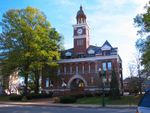Paris, Tennessee
Authors [about]:
join in to develop this article! |
Paris, Tennessee (USA) is a small town of about 10,000 people in West Tennessee. It was founded and incorporated in 1823. Paris is the county seat of Henry County (which has 32,363 residents in 2021, including Paris[1]). The county and town are struggling economically; as of 2021, the poverty rate of around 20% is more than twice the national average[2]. The county is in the upper right corner of West Tennessee bordered by Kentucky (north) and the Tennessee River (east).
The heart of downtown Paris is the court house built in 1897[3]. On the court house lawn is a statue of a confederate soldier[4], one of many monuments around the U.S. earmarked by the InvisibleHate.org website in 2020 as appropriate for removal (possibly to a less prominent location such as a private cemetery containing the remains of confederate soldiers).
In August of 2020, the Lee Academy for the Arts (402 Lee St.) was renamed as Paris Academy for the Arts, and its board of directors (formerly called the Robert E. Lee School Association) renamed itself as the Paris Academy Association. The site and building had born the name of confederate general Robert E. Lee for well more than a century.[5]
This is the reference for Van Dyke[6]. This reference is currently a placeholder and will be placed on the first occurrence when this article is near completion.
The indigenous people before European settlers
How the early European settlers obtained deeds to the land
The pre-civil-war schools
In the early 1800's when Paris was first founded, wealthier people sent their boys to private academy. Some girls also got "academy" (but modified, excluding classics and including more home-making/arts). Anyone else got so-called "common schools", if at all. Common schools arose which taught basic reading writing arithmetic to no more than 8th grade.
Even some slaves were given a basic education (taught to read, maybe). Free negroes, on the other hand, were not allowed to hold jobs, associate with slaves (or anyone besides other free negroes), and were not allowed to attend school at all.
The pre-civil-war economy
Slavery around the time of the civil war
In the 1850s, the decade leading up to the civil war, most of the economy of Henry County came from moderate-sized farms between 20 and 500 acres; their owners and families were the main demographic of the county at that time.[7]. Three other groups existed in small pockets only: large plantation owners, poor whites, and free negroes. Per the county census figures, a third of all heads of these farm families owned slaves in 1850. Tobacco and cotton were important crops, and the labor for those crops was done almost exclusively by slaves, who constituted a quarter of the overall population, but lived on only a third of the farms[8]. The county's slaveholders had great influence with politics of the day. Two-thirds of Henry County voters elected to secede from the union, and any Union sentiment in the remaining third of the population was brutally suppressed[9], not only in Henry County but in most of West and Middle Tennessee. During this period, Isham G. Harris and John D. C. Atkins, both strongly pro-southern in sentiment, were very popular and acted as the main political voices in Henry County[10].
In 1860, Henry County’s two largest landowners were William A. Tharpe (4938 acres) and J. J. Cooke (2590 acres). They were likewise holders of the most slaves, 94 and 77 respectively[11]
Cost of slaves in 1839
The following rates were paid for slaves in Henry County during a sale in February 1839:[12]:
- man: $900 to $1000
- woman: $700 to $900
- child: $600 to $800
In terms of 2021 monetary worth, the cost per slave would be:[13]
- man: $25,209 to $28,010
- woman: $19,607 to $25,209
- child: $16,806 to $22,408
It is important to realize that slave-owners had invested substantial funds in their source of labor and believed that abolition of slavery would ruin the economy and way of life. Their participation in the civil war for the South was in every way an attempt to protect against having their right to own slaves infringed. The struggles for and against slavery throughout the thirty years leading up to the civil war were apparent in almost all parts of the Southern states, as well as the newly added territories, where the questions were twofold: Would slavery be allowed in this new territory, and would the new territories have to return escaped Southern slaves to their masters?
1960's and Desegregation
Prior to about 1962, schools in Paris and Henry County were segregated. Beginning around the fall of 1962, schools began a gradual process of introducing selected students of color into the white schools, and by around 1969, the gradual process of combining schools was completed when a new high school (Henry County High School) opened up in the center of the county, in Paris. All students from all over the county were transported to the new, consolidated school without regard for race. A similar process played out at other age levels. Many of the smaller, remote, rural schools were forced to close and send students to consolidated schools in Paris. Prior to 1969, black high school students attended Central High School, a segregated school, and school children of all ages attended segregated schools. No online history of segregation for the town and county seems to exist; current web pages read as if segregation never existed.
During the same span of years, a gradual process of desegregation began taking place. For example, prior to this time, people of color going to see a film at the old Capitol Theater in Paris were required to enter by a side door and sit in a gallery separate from white people, and incidentally farther from the screen. Also, people of color were not allowed to eat in the same restaurants as white people (prior to the 1960's). There was some friction as these things began to change, and the black people faced continual low-grade opposition and some abuse, but the integration did continue. Also prior to the 1960's, black people were not welcome in the main part of town except possibly on a few occasions such as Mule Day (which was eventually replaced by the World's Biggest Fish Fry). And finally, people of color were never hired for most jobs. The only work for most black men (and most women or children too) was picking cotton. Women were sometimes hired as cooks, housekeepers or nannies in white households and white-owned restaurants, but they had to remain out of sight and out of mind or they would be fired. As racial issues played out nightly on TV screens, the people of Paris slowly made their own peace without major demonstrations or public incident.
Even throughout the 1970's, black men were seldom (if at all) hired for factory jobs.
Within the factories, white women began to be hired by the 1960's but often found themselves relegated to the lower-paying jobs.[14]
Image gallery
These will be placed later
References
- ↑ Henry County, Tennessee Population 2021 on World Population Review, last access 1/27/2021
- ↑ Henry Co., TN, Population Data Profile, last access 2/15/2021
- ↑ Per the National Geographic Tennessee River Valley website (last access on 11/30/2020), the 1897 Richardsonian Romanesque court house in Paris is the oldest working judicial building in West Tennessee.
- ↑ Waymarking: Henry Co. Confederate Monument, Paris, TN, last access 1/17/2021
- ↑ The PI (Paris Post-Intelligencer) Aug 28, 2020 article PARIS, TN: Former Lee school building gets name change, last access 2/15/2021
- ↑ Antebellum Henry County by Roger Raymond Van Dyke, West Tennessee Historical Society, Papers 1947-2015, Vol 33, 49pp; see page (tbd)
- ↑ WTHS, Van Dyke p 72
- ↑ WTHS, Van Dyke pp69-71
- ↑ WTHS Van Dyke, p 73 and p 78
- ↑ WTHS Van Dyke, p 74
- ↑ Chase Mooney, “Slavery in Tennessee”, 1957, Indiana University Press, Bloomington; 199pp as cited by Van Dyke p 25, footnote # 69
- ↑ WTHS Van Dyke p73
- ↑ https://www.officialdata.org/us/inflation/1839?amount=1
- ↑ This information is based on my personal memory of having grown up in Paris, TN, and attended the schools from 1958 until 1971. Pat Palmer


